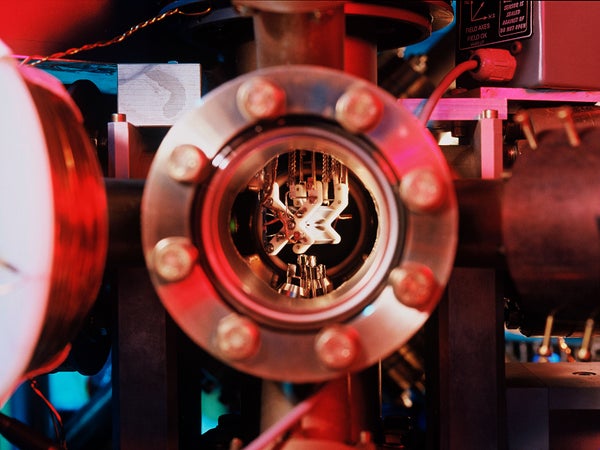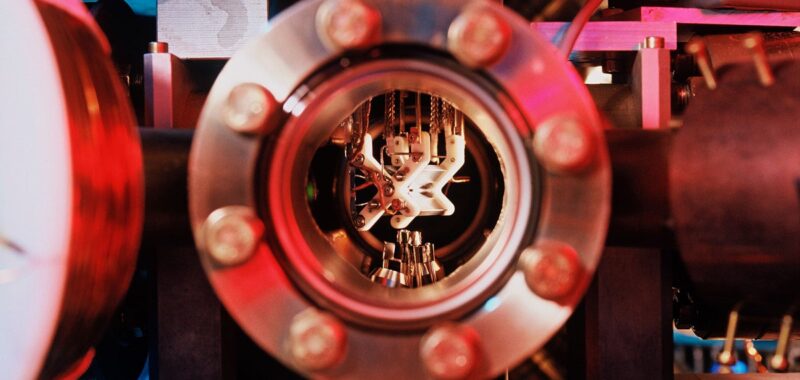How ‘Qudits’ Could Boost Quantum Computing
“Qudits,” the multi-dimensional cousins of qubits, could make quantum computers more efficient and less prone to error

Part of the quantum computer at Innsbruck University, on which researchers did simulations using qutrits and ququints.
C. Lackner/University of Innsbruck
Quantum computing has so far nearly always involved calculating with qubits—quantum objects that can take the value ‘0’ or ‘1,’ like ordinary computer bits, but that can also be in a range of combinations of 0 and 1. Now researchers are producing the first applications of ‘qudits:’ units of information that offer combinations of three or more simultaneous states.
In a paper published on 25 March in Nature Physics, physicists describe how they used ‘qutrits’ and ‘ququints’—qudits with three and five states respectively—to simulate how high-energy quantum particles interact through an electromagnetic field. The work follows a result published in Physical Review Letters (PRL) in September that reproduced the behaviour of another quantum field, that of the strong nuclear force, using qutrits.
Such simulations of quantum fields are seen as one of the most promising applications of quantum computers, because these machines could predict phenomena in particle colliders or chemical reactions that are beyond the abilities of ordinary computers to calculate. Qudits are naturally suited to this task, says theoretical physicist Christine Muschik, a co-author of the Nature Physics paper who also pioneered such simulations with qubits in 2016 together with colleagues at the University of Innsbruck, Austria. “If I could go back in time to my old self, I would tell her: why waste time with qubits?” says Muschik, who is now at the University of Waterloo, Canada.
On supporting science journalism
If you’re enjoying this article, consider supporting our award-winning journalism by subscribing. By purchasing a subscription you are helping to ensure the future of impactful stories about the discoveries and ideas shaping our world today.
“This qudit approach is not a solution to everything, but it helps you when it is suitable to the problem,” says Martin Ringbauer, an experimental physicist at the University of Innsbruck and the lead author of the paper.
More generally, qudits can help to make calculations on a quantum computer more efficient and less error-prone, at least on paper. With qudits, each computational unit that previously encoded a qubit—such as a trapped ion or a photon—can suddenly pack in more information, helping the machines to scale up faster. But the tactic is less mature than approaches based on qubits, and the devil could be in the detail. “Qudits are also more complicated to work with,” says Benjamin Brock, an experimental physicist at Yale University in New Haven, Connecticut.
System tweaks
In most types of quantum computer, the qubits that researchers use are two possible states of a system that would naturally have many more states. Such a system could therefore host qudits as well. “Existing qubit processors such as those of IBM and Google can already be operated as qutrits, and would require minor tweaks to operate as high-dimensional qudits,” says Machiel Blok, a physicist at the University of Rochester, New York. (Blok and his team have done experiments in their laboratory in which superconductors encoded qudits of up to 12 levels.)
For their quantum-field simulations, the authors of the PRL paper encoded qutrits on a superconducting quantum chip that IBM makes available to researchers, and that is normally used as a qubit machine. Ringbauer, Muschik and their colleagues used excited states of calcium ions to represent their five-level ququints. A ququint is a natural way to represent a field that can be in a lowest-energy state (with value 0) or have positive or negative values from −2 to +2 at any point in space, Muschik says.
In the future, such simulations could help to explain how quarks stick together to form protons, or how neutrinos collide with one another in the intense environment of a supernova explosion, physicists say. “There’s great hope that there’s going to be new effects that we can identify even with modest-size quantum computers,” says Martin Savage, a physicist at the University of Washington in Seattle.
Error correction
In principle, any calculation that can be done with qubits can also be done with qudits of any dimension, and vice versa: any qudit can be encoded in a set of qubits. But sharing information among multiple qubits is notoriously tricky and can introduce computational errors. Executing a quantum algorithm on qudits could require fewer steps, and therefore have a lower chance of introducing errors, says Muschik.
Theorists have devised sophisticated ‘quantum error correction’ schemes to catch and fix errors by spreading information across more and more qubits to lower the error rate. In principle, qudits could reduce that overhead and still yield the same level of error correction, but experimentally, “there is a complicated list of trade-offs”, says theorist Earl Campbell, vice-president of quantum science at Riverlane, a start-up quantum-software company in Cambridge, UK. “Building a code for qudits is a bit harder.”
In a preprint posted last September, Brock and his collaborators encoded a qudit as the energy levels of trapped microwaves, and used some of the extra available dimensions to increase the redundancy of the information and thereby correct errors. “We need quantum error correction with qudits if they’re going to be useful in the long term,” Brock says. But he adds that “it is less clear, at least at the moment, what a large-scale quantum computer using qudits would look like.”
This article is reproduced with permission and was first published on March 25, 2025.

